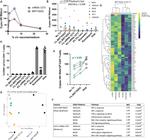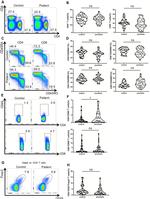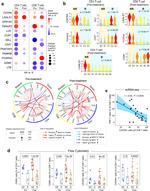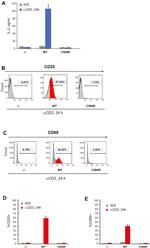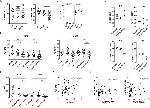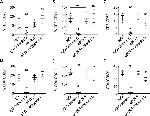Product References
SARS CoV-2 mRNA vaccination exposes latent HIV to Nef-specific CD8+ T-cells.
Nature communications
Stevenson EM,Terry S,Copertino D,Leyre L,Danesh A,Weiler J,Ward AR,Khadka P,McNeil E,Bernard K,Miller IG,Ellsworth GB,Johnston CD,Finkelsztein EJ,Zumbo P,Betel D,Dündar F,Duncan MC,Lapointe HR,Speckmaier S,Moran-Garcia N,Papa MP,Nicholes S,Stover CJ,Lynch RM,Caskey M,Gaebler C,Chun TW,Bosque A,Wilkin TJ,Lee GQ,Brumme ZL,Jones RB
Published figure using CD69 monoclonal antibody (Product # 17-0699-42) in Flow Cytometry
Fri Aug 19 00:00:00 EDT 2022
Modification of Hinge/Transmembrane and Signal Transduction Domains Improves the Expression and Signaling Threshold of GXMR-CAR Specific to Cryptococcus spp.
Cells
Dos Santos MH,Machado MP,Kumaresan PR,da Silva TA
17-0699-42 was used in Flow cytometry/Cell sorting to optimize novel second-generation GXMR-CARs containing the CD8-hinge/transmembrane domain that improved CAR expression, antigen recognition, and signal strength in T-cell activation.
Wed Oct 26 00:00:00 EDT 2022
Cancer-secreted exosomal miR-1468-5p promotes tumor immune escape via the immunosuppressive reprogramming of lymphatic vessels.
Molecular therapy : the journal of the American Society of Gene Therapy
Zhou C,Wei W,Ma J,Yang Y,Liang L,Zhang Y,Wang Z,Chen X,Huang L,Wang W,Wu S
Published figure using CD69 monoclonal antibody (Product # 17-0699-42) in Flow Cytometry
Wed Apr 07 00:00:00 EDT 2021
Dysregulated Peripheral Invariant Natural Killer T Cells in Plaque Psoriasis Patients.
Frontiers in cell and developmental biology
Hu Y,Chen Y,Chen Z,Zhang X,Guo C,Yu Z,Xu P,Sun L,Zhou X,Gong Y,Yu Q,Shi Y
Published figure using CD69 monoclonal antibody (Product # 17-0699-42) in Flow Cytometry
Wed Feb 23 00:00:00 EST 2022
T cell receptor-dependent S-acylation of ZAP-70 controls activation of T cells.
The Journal of biological chemistry
Tewari R,Shayahati B,Fan Y,Akimzhanov AM
Published figure using CD69 monoclonal antibody (Product # 17-0699-42) in Flow Cytometry
Thu Aug 26 00:00:00 EDT 2021
Identification of celastrol as a novel HIV-1 latency reversal agent by an image-based screen.
PloS one
Liu H,Hu PW,Dubrulle J,Stossi F,Nikolai BC,Mancini MA,Rice AP
Published figure using CD69 monoclonal antibody (Product # 17-0699-42) in Flow Cytometry
Tue Sep 14 00:00:00 EDT 2021
Human endoglin-CD3 bispecific T cell engager antibody induces anti-tumor effect in vivo.
Theranostics
Zhong L,Shi W,Gan L,Liu X,Huo Y,Wu P,Zhang Z,Wu T,Peng H,Huang Y,Zhao Y,Yuan Y,Deng Z,Tang H
Published figure using CD69 monoclonal antibody (Product # 17-0699-42) in Flow Cytometry
Wed Jul 28 00:00:00 EDT 2021
Longitudinal single-cell profiling reveals molecular heterogeneity and tumor-immune evolution in refractory mantle cell lymphoma.
Nature communications
Zhang S,Jiang VC,Han G,Hao D,Lian J,Liu Y,Zhang R,McIntosh J,Wang R,Dang M,Dai E,Wang Y,Santos D,Badillo M,Leeming A,Chen Z,Hartig K,Bigcal J,Zhou J,Kanagal-Shamanna R,Ok CY,Lee H,Steiner RE,Zhang J,Song X,Nair R,Ahmed S,Rodriquez A,Thirumurthi S,Jain P,Wagner-Bartak N,Hill H,Nomie K,Flowers C,Futreal A,Wang L,Wang M
Published figure using CD69 monoclonal antibody (Product # 17-0699-42) in Flow Cytometry
Mon May 17 00:00:00 EDT 2021
Therapeutic effect of kaempferol on atopic dermatitis by attenuation of T cell activity via interaction with multidrug resistance-associated protein 1.
British journal of pharmacology
Lee HS,Jeong GS
17-0699-42 was used in Flow cytometry/Cell sorting to examine the therapeutic potential of kaempferol in atopic dermatitis by modulating T cell activation.
Thu Apr 01 00:00:00 EDT 2021
Coagulation factor V is a marker of tumor-infiltrating immune cells in breast cancer.
Oncoimmunology
Tinholt M,Stavik B,Tekpli X,Garred Ø,Borgen E,Kristensen V,Sahlberg KK,Sandset PM,Iversen N
Published figure using CD69 monoclonal antibody (Product # 17-0699-42) in Flow Cytometry
Tue Sep 29 00:00:00 EDT 2020
Unique natural killer cell subpopulations are associated with exacerbation risk in chronic obstructive pulmonary disease.
Scientific reports
Osterburg AR,Lach L,Panos RJ,Borchers MT
Published figure using CD69 monoclonal antibody (Product # 17-0699-42) in Flow Cytometry
Mon Jan 27 00:00:00 EST 2020
Transcriptional down-regulation of ccr5 in a subset of HIV+ controllers and their family members.
eLife
Gonzalo-Gil E,Rapuano PB,Ikediobi U,Leibowitz R,Mehta S,Coskun AK,Porterfield JZ,Lampkin TD,Marconi VC,Rimland D,Walker BD,Deeks S,Sutton RE
Published figure using CD69 monoclonal antibody (Product # 17-0699-42) in Flow Cytometry
Tue Apr 09 00:00:00 EDT 2019
Heterogeneity of human bone marrow and blood natural killer cells defined by single-cell transcriptome.
Nature communications
Yang C,Siebert JR,Burns R,Gerbec ZJ,Bonacci B,Rymaszewski A,Rau M,Riese MJ,Rao S,Carlson KS,Routes JM,Verbsky JW,Thakar MS,Malarkannan S
Published figure using CD69 monoclonal antibody (Product # 17-0699-42) in Flow Cytometry
Mon Sep 02 00:00:00 EDT 2019
Glossogyne tenuifolia (Hsiang-ju) extract suppresses T cell activation by inhibiting activation of c-Jun N-terminal kinase.
Chinese medicine
Houng JY,Tai TS,Hsu SC,Hsu HF,Hwang TS,Lin CJ,Fang LW
Published figure using CD69 monoclonal antibody (Product # 17-0699-42) in Flow Cytometry
Wed Sep 30 00:00:00 EDT 2020
Hormonal vitamin D up-regulates tissue-specific PD-L1 and PD-L2 surface glycoprotein expression in humans but not mice.
The Journal of biological chemistry
Dimitrov V,Bouttier M,Boukhaled G,Salehi-Tabar R,Avramescu RG,Memari B,Hasaj B,Lukacs GL,Krawczyk CM,White JH
Published figure using CD69 monoclonal antibody (Product # 17-0699-42) in Flow Cytometry
Fri Dec 15 00:00:00 EST 2017
Combinations of isoform-targeted histone deacetylase inhibitors and bryostatin analogues display remarkable potency to activate latent HIV without global T-cell activation.
Scientific reports
Albert BJ,Niu A,Ramani R,Marshall GR,Wender PA,Williams RM,Ratner L,Barnes AB,Kyei GB
Published figure using CD69 monoclonal antibody (Product # 17-0699-42) in Flow Cytometry
Mon Aug 07 00:00:00 EDT 2017
MAIT cells are activated during human viral infections.
Nature communications
van Wilgenburg B,Scherwitzl I,Hutchinson EC,Leng T,Kurioka A,Kulicke C,de Lara C,Cole S,Vasanawathana S,Limpitikul W,Malasit P,Young D,Denney L,Moore MD,Fabris P,Giordani MT,Oo YH,Laidlaw SM,Dustin LB,Ho LP,Thompson FM,Ramamurthy N,Mongkolsapaya J,Willberg CB,Screaton GR,Klenerman P
Published figure using CD69 monoclonal antibody (Product # 17-0699-42) in Flow Cytometry
Thu Jun 23 00:00:00 EDT 2016
Production of bispecific antibodies in "knobs-into-holes" using a cell-free expression system.
mAbs
Xu Y,Lee J,Tran C,Heibeck TH,Wang WD,Yang J,Stafford RL,Steiner AR,Sato AK,Hallam TJ,Yin G
17-0699 was used in Flow cytometry/Cell sorting to develop a cell-free expression system to produce knobs-into-holes bispecific antibodies in multiple scaffolds.
Mon Sep 28 00:00:00 EDT 2015
HIV Tat controls RNA Polymerase II and the epigenetic landscape to transcriptionally reprogram target immune cells.
eLife
Reeder JE,Kwak YT,McNamara RP,Forst CV,D'Orso I
Published figure using CD69 monoclonal antibody (Product # 17-0699-42) in Flow Cytometry
Wed Oct 21 00:00:00 EDT 2015
RSV-specific airway resident memory CD8+ T cells and differential disease severity after experimental human infection.
Nature communications
Jozwik A,Habibi MS,Paras A,Zhu J,Guvenel A,Dhariwal J,Almond M,Wong EHC,Sykes A,Maybeno M,Del Rosario J,Trujillo-Torralbo MB,Mallia P,Sidney J,Peters B,Kon OM,Sette A,Johnston SL,Openshaw PJ,Chiu C
Published figure using CD69 monoclonal antibody (Product # 17-0699-42) in Flow Cytometry
Mon Dec 21 00:00:00 EST 2015
Alternative capture of noncoding RNAs or protein-coding genes by herpesviruses to alter host T cell function.
Molecular cell
Guo YE,Riley KJ,Iwasaki A,Steitz JA
Published figure using CD69 monoclonal antibody (Product # 17-0699-42) in Flow Cytometry
Thu Apr 10 00:00:00 EDT 2014
Biallelic loss-of-function mutation in NIK causes a primary immunodeficiency with multifaceted aberrant lymphoid immunity.
Nature communications
Willmann KL,Klaver S,Doğu F,Santos-Valente E,Garncarz W,Bilic I,Mace E,Salzer E,Conde CD,Sic H,Májek P,Banerjee PP,Vladimer GI,Haskoloğlu S,Bolkent MG,Küpesiz A,Condino-Neto A,Colinge J,Superti-Furga G,Pickl WF,van Zelm MC,Eibel H,Orange JS,Ikincioğulları A,Boztuğ K
17-0699 was used in Flow cytometry/Cell sorting to study the effect of a biallelic mutation in the gene encoding NF-κB-inducing kinase on immune cell populations.
Wed Nov 19 00:00:00 EST 2014
Ex vivo analysis of resident hepatic pro-inflammatory CD1d-reactive T cells and hepatocyte surface CD1d expression in hepatitis C.
Journal of viral hepatitis
Yanagisawa K,Yue S,van der Vliet HJ,Wang R,Alatrakchi N,Golden-Mason L,Schuppan D,Koziel MJ,Rosen HR,Exley MA
Published figure using CD69 monoclonal antibody (Product # 17-0699-42) in Flow Cytometry
Thu Aug 01 00:00:00 EDT 2013
Monocytes regulate the mechanism of T-cell death by inducing Fas-mediated apoptosis during bacterial infection.
PLoS pathogens
Daigneault M,De Silva TI,Bewley MA,Preston JA,Marriott HM,Mitchell AM,Mitchell TJ,Read RC,Whyte MK,Dockrell DH
17-0699 was used in Flow cytometry/Cell sorting to elucidate the mechanisms that regulate levels of activated T-cells at sites of acute bacterial infection.
Tue Jan 29 00:00:00 EST 2013
Fc receptor-like 3 protein expressed on IL-2 nonresponsive subset of human regulatory T cells.
Journal of immunology (Baltimore, Md. : 1950)
Nagata S,Ise T,Pastan I
17-0699 was used in Flow cytometry/Cell sorting to study the effects of Foxp3 and IL-2 on FCRL3-/+ nTreg cell subsets.
Mon Jun 15 00:00:00 EDT 2009

